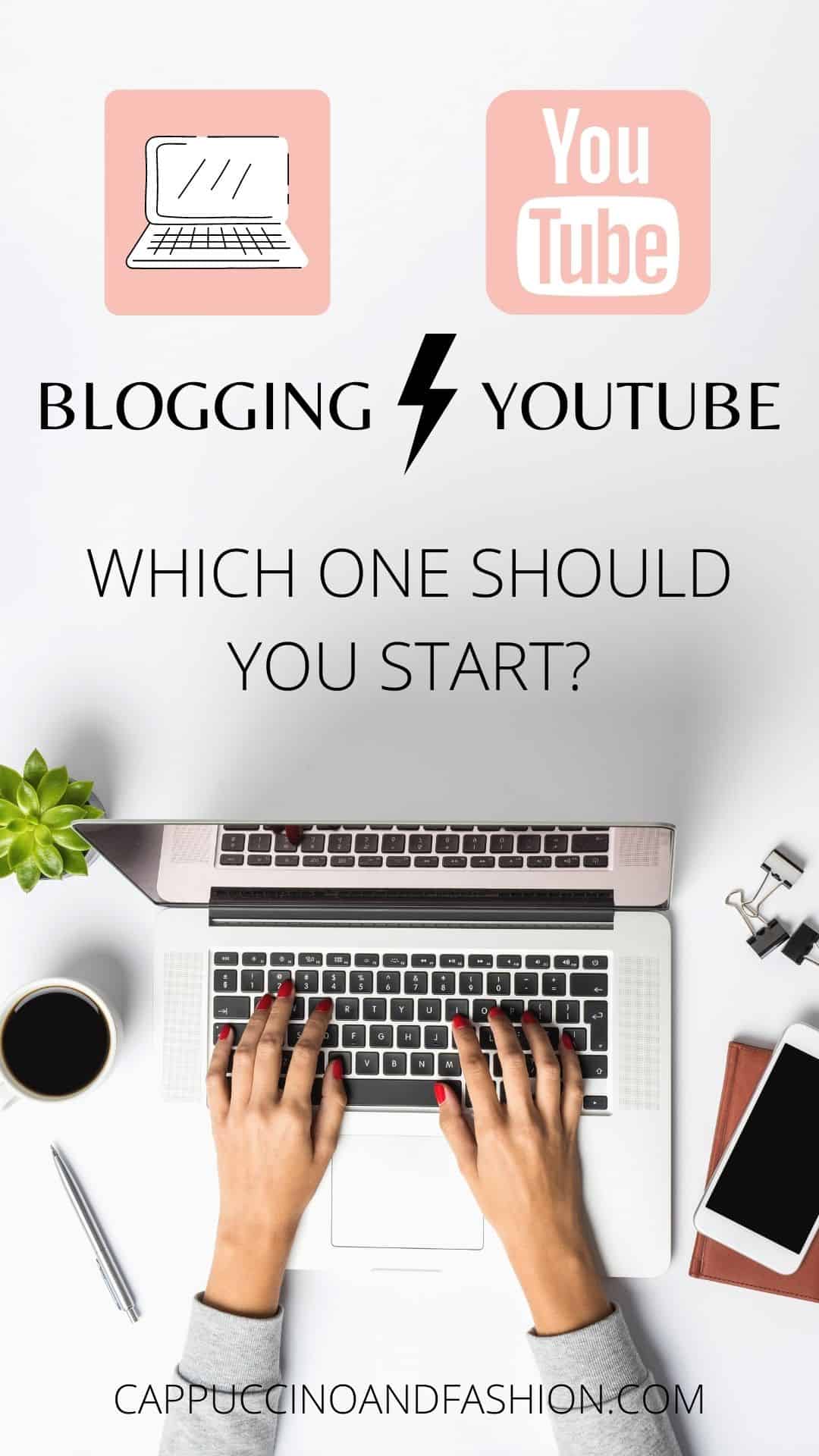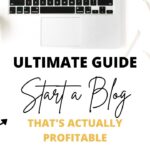This post may contain affiliate links, meaning I make a commission if you purchase through my links, at no extra cost to you. Disclosure here.
Are you thinking about creating an online presence for yourself, but you’re not sure whether you should start a blog or a YouTube channel? Let’s talk about blogging vs YouTube in 2022 and which one you should pick.
Should I start a blog or a YouTube channel? If you’re more comfortable writing and prefer not to be on a camera, you should start a blog. If you don’t mind being on camera and feel confident learning video editing skills, then a YouTube channel is best for you.
Let’s dive into the details of each and help you decide which one you should pick.

Disclaimer: This post has been included as an entry into a giveaway/sweepstakes.
Blogging vs YouTube
I started my blog CappuccinoandFashion.com nearly 8 years ago now as a pure hobby. The process of starting a blog was much easier for me in terms of comfort rather than doing videos on YouTube.
Starting my YouTube channel took a lot more getting out of my comfort zone and learning new skills that I didn’t really have beforehand, like filming and editing videos.
Like every other youtuber in the beginning, I felt so strange being on camera and talking to myself basically when I just got started.
However, I’m really glad I started both, because they have both helped grow my online business to what it is today. I am now able to work from home full-time on this online business that I run through my blog and YouTube channel.
But which one should you pick? Blogging or YouTube?
Here are 13 things you should keep in mind when you’re making this decision.
1. Level of comfort being on camera
This one is a tricky one, because no one is comfortable on camera at first. Starting to film yourself for YouTube can feel really awkward and it’s out of everyone’s comfort zone when they’re just getting started.
If deep down you would like to do YouTube, but you’re feeling a bit weird on camera, then this is not a reason for you to avoid it.
Yes, your first few video will feel weird to film, but the more you do it the easier it gets and the more comfortable you will feel in front of the camera.
So if this is something you are passionate about, don’t let the initial awkwardness in front of the camera hold you back.
However, if you really do not want to be on a camera at all, a blog is probably the better option for you.
I don’t recommend having a completely anonymous blog, because people need to see the person behind it in order to trust you and for you to be able to build a powerful online brand for yourself.
The difference between YouTube and a blog is that on your blog you can just put a headshot picture of yourself, and you don’t have to put a full video of you talking, which is more nerve-wrecking for a lot of people.
2. The skills required
The skills needed for each of these platforms are a bit different as well. As you read through these, keep in mind that you do not need to already have these skills. These are things that you can learn in time as you grow and progress.
For a blog, you will need the following skills:
- Basic photography skills – If you need to take your own photos. Or alternatively you can use the stock photos for niche websites that don’t need original photos 100% of the time.
- Writing skills – You will need to know basic writing, how to outline a post, how to write eloquent and grammatically correct sentences. Again, this is something you can learn in time or you can use tools to help you do this with greater ease.
- Basic graphic design skills – You will need some very basic graphic design knowledge to help you create logos, featured images, Pinterest pin graphics or any other social media designs you might need.
- SEO knowledge – You will also need to know at least some very basic SEO, in order to have a chance for your blog post to rank in Google Search or in Pinterest search. This is the way to ensure that your blog posts get seen and get traffic to them.
For a YouTube channel, you will need the following skills:
- Basic photography skills – You will very likely need some photography skills for your YouTube channel as well, because you will need to use photos for your thumbnails and graphics that you might present in your video.
- Video recording skills – You will need to learn how to record a video properly, how to set up a good background for your videos, basic lighting knowledge and how to use your camera settings in order to get a good quality video.
- Video editing skills – You will then need to learn an editing software, so that you can do editing on your videos. You do not need to know fancy editing techniques or use pro transitions all the time. Just some basic video editing will work fine.
- Basic graphic design skills – Some basic graphic design knowledge will be necessary in order to create eye-catching thumbnails for YouTube videos. Thumbnails are a very important part of getting your videos seen, because that’s what people first see when they stumble upon your video and it will determine whether or not they actually click on it.
- SEO knowledge – YouTube is also a search engine, so you will need some basic search engine optimisation knowledge in order to help you rank in YouTube and get more views on your videos.
3. Equipment you need
There are different things that you will need for starting a blog as opposed to running a YouTube channel.
The equipment you need for a blog:
- Laptop with internet connection – In order to start writing blog posts, you only need a laptop with decent internet connection. No other physical tools are absolutely necessary in order to run a successful blog.
- Camera (optional) – A camera is optional, depending on the type of blog that you will run and niche that you write on. Obviously, if it’s a very visual type of niche, such as photography, food or fashion, a good camera will be absolutely necessary. But for lots of other niches, you can actually get away with using stock photos for some of your blog posts.
The equipment you need for a YouTube channel:
- Laptop with internet connection – In order to start creating videos for your YouTube channel, you will also need a laptop with a good internet connection obviously.
- Good camera – A good camera is really important when you are starting a YouTube channel, because video quality is huge in order to grow on the platform. You could potentially start filming videos on your smartphone, but you will likely outgrow that very fast and will need to invest in a proper camera.
- Microphone (optional) – A separate microphone is optional, depending on how good your camera is at recording audio or how often you need to record voiceovers for your videos.
- Video editing software – Another thing that will be absolutely necessary for a YouTube channel is a video editing software. You can use something very basic, even the free iMovie. I also recently found out that Canva actually have a free editor you can use (Canva’s free video editor), which looks really helpful for this. But you will need some sort of software to do basic editing on your videos.

4. Expenses
Both blogging and starting a YouTube channel come with a certain cost involved. Here is what you might expect to pay for starting your blog versus your YouTube channel.
Expenses you absolutely need on a blog when just starting out:
- Hosting and domain package – a self hosted blog is absolutely necessary if you want to make this a platform that you monetise. You can purchase a hosting and domain package from Bluehost, which I highly recommend for bloggers who are just starting out. This usually costs around $3.95 dollars per month, which is a very small investment to start an online business.
Expenses you will need on a YouTube channel to start out:
- No cost for joining the platform – Creating a YouTube channel and posting videos on it is completely free, so you do not need to pay anything to join the platform.
- A smartphone with a good camera to start – In order to start creating videos, you will at least need a good camera on your smartphone with a decent audio quality on it. However, you will likely outgrow this very fast and will need to invest in a better quality camera.
- Camera and microphone eventually – A good camera for filming videos and a microphone will really help take your content to the next level and will ensure that your videos are good quality.
5. Where your audience hangs out
Having a specific niche for your blog or your YouTube channel can be the hardest decisions you will have to make. But one thing you can do to make this easier is to define your target audience instead.
Figure out what type of person is more likely to enjoy your blog post or YouTube videos.
What are they interested in?
What age are they? What profession are they in? Are they students, mums, career oriented people etc?
Be as detailed as possible when describing your target audience, because this will help you figure out exactly the type of content you need to create for them.
Once you have your target audience figured out, you will be able to make an informed decision on whether they hang out more in the blogging world or on YouTube.
Would they prefer reading a post or watching a video?
But in all honesty, for most niches there will be an audience on both platforms, so you can likely choose either one of them that you prefer.
6. Competition for your niche
Once you have a niche figured out, even if it’s something a bit more broad at first, you can start looking into competition.
You can do a Google or YouTube search yourself and see if there are any other big channels in your niche. If you can find a lot of big channels or blogs writing about the same topic that you want to write about, that’s not necessarily a bad thing.
It just means that you might have to niche down a bit further somehow. This will help you stand out from the crowd and will help you achieve growth faster.
Getting to know the competition in your niche on both platforms can be super helpful when you decide which one you want to start on.

7. Keyword research & SEO
On both a blog and a YouTube channel, SEO and keyword research are very important. The main goal for both of these in order to start getting traffic or views is to rank in Google Search or in YouTube search.
This means you will need to learn how to perform some basic keyword research, in order to find good keywords that you can create content about and have a chance to rank for.
The main point for both of these is to find keywords that are not super competitive, but that get a decent amount of traffic or searches per month.
We dive into the exact strategy for finding good keywords in the Blogging Secrets course, so that you don’t waste years writing about the wrong topics.
8. A platform you own
One huge difference and something that’s very important in this comparison between blogging and YouTube is the control you have over it.
For your blog, it is highly recommended that you start a self hosted blog on WordPress, which means you will need to buy a hosting and domain package. If you need the exact steps on how to do this, you can check out my how to start a blog complete guide for beginners that’s completely free.
But what this means is you own your blog. It is your own platform that you control and it is completely yours.
YouTube, on the other hand, is not yours. You do not own it. What this means is YouTube can make changes to the platform, to the algorithm or to your channel without you having any control over it.
They can choose to shut down your channel or demonetise it at any point. Of course, this is a worst case scenario. But if you build a full business solely on YouTube, it can be a bit of a risky situation.
This is why having a blog is so important, because it is the one platform that you own.
9. Ways of monetising a blog vs a YouTube channel
When it comes to monetising a blog or a YouTube channel, there are multiple ways in which these are similar.
Here are the ways to monetise a blog:
- Display ads – You join an ad network which then allows you to place ads in the content on your blog and you make money from each impression on those ads. For your blog, you have multiple choices of ad networks that you can join to monetise in this way. For example: Google Adsense, Mediavine, Ezoic, Adthrive etc.
- Affiliate marketing – You can place affiliate links in your blog posts and make a commission whenever someone makes a purchase through your link.
- Sponsored posts – Brands or companies pay you to create a post all about their products or services that they offer.
- Selling physical or digital products – You can also monetise your blog through selling physical or digital products on it.
- Selling services – Another way to monetise a blog is through offering your services, such as coaching, consulting, website developing, branding services, graphic design etc.
Here are the ways to monetise a YouTube channel:
- Display ads – You can monetise your YouTube channel through display ads as well, but the difference is that Google Adsense is the only option here.
- Affiliate marketing – Similar to a blog, you can monetise through affiliate links by placing them in your description box.
- Sponsored videos – Brands will pay you to include their product in your videos, usually at the beginning part of the video for 2-3 minutes depending on the contract you agree on.
- Selling physical or digital products – You can drive people from your YouTube channel to your products or maybe even showcase them in your videos.
- Selling services – You can also mention the services that you offer in your videos, but you will usually need another platform like a blog where you showcase your services in detail.

10. Blog vs Vlog income
The income you make on either your blog or your YouTube channel can vary greatly depending on the monetisation strategies you apply.
If we’re talking strictly about display ads, the RPM (or Rate Per Mille = Rate per 1000 sessions) is much lower on Google Adsense in comparison to a higher end network such as Mediavine.
Your RPM will vary depending on your niche, the country where most of your audience is, how long they watch your video or read your blog post for etc.
It is hard to pinpoint an absolute average number for every blog or channel out there since every niche is so different. But a $5 RPM for Google Adsense is very common, while for Mediavine it is much more likely for you to see a $20-$30 RPM.
What does this mean for your monthly income?
Let’s say one month you get 50,000 pageviews on your blog monetised with Mediavine. And you get 50,000 views on your YouTube channel monetised with Google Adsense.
Here’s how much you would make from each:
- 50,000 blog pageviews → 50 x $30 RPM = $1,500
- 50,000 YouTube views → 50 x $5 RPM = $250
As you can see there is quite a big difference between the two when it comes to the income you can make strictly from display ads.
However, both a blog and a YouTube channel can be highly profitable, especially if you don’t rely simply on displaying ads. If you use the other monetising strategies above, you will likely see a very good income from either of these.
11. The trust factor
The trust factor is something that’s not talked about very often, but it makes a big difference when it comes to trying to grow an online business.
When someone comes to your blog, it can be harder for them to instantly create a connection to you from reading your articles. However, when someone watches a YouTube video of you, they start to feel like they know you. And if they can relate to you in any way, this also instantly boosts the trust that they have in you.
Building up your brand and your trust is very important when you’re trying to become an authority in any niche and make money from it.
12. Time to invest
The time you need to invest on both platforms is significant. There are lots of tasks that you need to do on each of these platforms, a lot of them behind the scenes, content planning and admin tasks.
But if we look strictly at creating one piece of content for each platform, here is how much time you can expect to invest.
For a blog post, you will usually need to write at least 1,000+ words, add some images to your post and do some final proofreading. Depending on how fast of a writer you are, this can take you a few hours to complete.
Creating a YouTube video is much more demanding. You will need to set up your background, your camera, your lighting equipment and microphone, if you use one.
You will then go on to record your video. This can take as little as half an hour if it’s a short sit-down video.
Or it can take hours if it’s a more intricate video, such as a full cleaning routine or a daily routine of some sort.
After filming is done, depending on the amount of footage that you have, it can take you a few hours to edit the final video.
From a time investment perspective, it is much quicker to write a blog post than it is to create a YouTube video.
13. Updating old posts
One thing that you can do on a blog, but you can’t really do on your YouTube channel is the fact that you can update old blog posts.
In order to keep content relevant, you can always go back to your old blog posts and edit them, add any new information, change the images, improve the SEO etc.
However, once your video is up, you cannot really go back to edit it or add more footage to that video in the future. You can only edit the description box if needed.
From this point of view, it is much easier to keep your content relevant throughout the years on a blog rather than on a YouTube channel.
Should I start a blog or a YouTube channel in 2022?
One of the best decisions you can take in this case is to start both a blog and a YouTube channel. This will give you maximum exposure on both platforms and it will help you grow on both at the same time.
You can also link from your blog to your YouTube channel and vice versa to drive more traffic to each one of those.
This will help you build more trust with your audience by being more personable in a YouTube video, whilst also having a platform that you own, AKA your blog.
Use the table below to help you make an informed decision on whether you should start a blog or YouTube channel in 2022:
| BLOGGING | YOUTUBE | |
| Comfort on camera | You don’t have to be on camera. | You have to get comfortable being on camera. |
| Skills required | ✅ Basic photography skills ✅ Basic graphic design skills ✅ SEO knowledge ✅ Writing skills ❌ Video recording skills ❌ Video editing skills | ✅ Basic photography skills ✅ Basic graphic design skills ✅ SEO knowledge ❌ Writing skills ✅ Video recording skills ✅ Video editing skills |
| Equipment required | ✅ Laptop with internet connection ❌ Good camera (optional, depending on niche) ❌ Microphone ❌ Video editing software | ✅ Laptop with internet connection ✅ Good camera ✅ Microphone (optional) ✅ Video editing software |
| Expenses | ✅ Platform cost: inexpensive hosting and domain package (around $3.95/month) ❌ Good camera ❌ Microphone | ❌ Platform cost (free to join) ✅ Good camera (or at least good smartphone) ✅ Microphone |
| Where audience is | For most niches, your target audience will be on both platforms. | For most niches, your target audience will be on both platforms. |
| Niche competition | Research competition for your niche on blogs. | Research competition for your niche on YouTube. |
| Keyword research & SEO | ✅ Yes, you need basic SEO knowledge for a blog. | ✅ Yes, you need basic SEO knowledge for a YouTube channel. |
| Platform you own | ✅ Yes, you own your blog. | ❌ No, you do not own your YouTube channel. |
| Way of monetising | ✅ Display ads: – ✅ Google Adsense – ✅ Mediavine – ✅ Ezoic – ✅ AdThrive etc. ✅ Affiliate marketing ✅ Sponsored posts ✅ Selling physical or digital products ✅ Offering services | ✅ Display ads: – ✅ Google Adsense – ❌ Mediavine – ❌ Ezoic – ❌ AdThrive etc. ✅ Affiliate marketing ✅ Sponsored posts ✅ Selling physical or digital products ✅ Offering services |
| Income levels | ✅ Highly profitable display ads/monthly views ✅ Highly profitable through the other strategies (affiliate, sponsors, products and services). | ❌ Less profitable display ads/monthly views ✅ Highly profitable through the other strategies (affiliate, sponsors, products and services). |
| Trust factor | ❌ Harder for people to connect and trust you. | ✅ Easier for people to connect and trust you. |
| Time to invest | ✅ Quicker to create one blog post. | ❌ Takes longer to create one YouTube video. |
| Updating old content | ✅ Can easily update old posts to keep relevant. | ❌ Cannot really update old videos. |
FAQ
Is YouTube a blogging platform?
YouTube is not a blog, it is a vlogging platform. So instead of having a collection of written blog posts, it has video logs or vlogs. The content on it is different from the type of content you would put on a blog or a regular website.
Is blogging better than YouTube?
Whether blogging is better than YouTube is mostly up to you.
There are various pros and cons to both of these, but it highly depends on how comfortable you are in front of the camera, how you are planning to monetise your content and which type of content you are most passionate about creating.
Is blogging still relevant in 2022?
Yes, blogging is absolutely still relevant in 2022. There are tons of bloggers out there who make a living from their blogs.
The reason why a lot of people assume YouTubers are more successful than bloggers is the fact that on YouTube you can see everybody’s video views publicly. Whereas on a blog you do not know how much traffic that blog is getting for each post.
Blogging is still very lucrative and can easily make you a full-time income as well.

Is it profitable to start a YouTube channel?
Yes, starting a YouTube channel can be highly profitable. However, it can take months or years before you start seeing a good income from YouTube if you solely rely on display ads from Google Adsense.
This is why I recommend looking into the other monetising options mentioned above and using those from the very beginning, while you are working to grow your YouTube channel.
Is it worth becoming a YouTuber in 2022?
Yes. It is absolutely not too late to become a YouTuber and start making a good income from your YouTube channel. The best time to start is right now. The earlier you start, the faster you will reach your income goals on the platform.
If YouTube is something you are passionate about, I highly recommend you start creating videos because it is a very lucrative platform to be on.
Which is best for earning, blogging or YouTube?
The monetising options for both a blog and a YouTube channel are very similar. For both of these you can monetise through display ads, affiliate links, sponsored posts, selling your own physical or digital products or offering your services.
You can make a very good income from both of these platforms.
Is YouTube harder than blogging?
YouTube is harder than blogging in the sense that it is more time consuming and it requires more skills than blogging. For a blog, your basic tasks are to write and to possibly create images for your blog posts.
On a YouTube channel, however, you will need to learn filming, basic lighting and editing skills in order to create quality videos. The process of creating a YouTube video can take much longer than writing a blog post.
Should I blog or vlog?
Both blogging and vlogging can be very lucrative. You can make a full-time income or even exceed that from both platforms, as long as you stay consistent and you put in the work.
They each have their pros and cons.
But what I would recommend – and what I am currently doing for my business as well – is to start both a blog and a YouTube channel.
This will help them grow simultaneously, which will give you more exposure, more monetising options and you also get to learn new skills from both.
I hope this article on blogging vs YouTube was helpful in making a decision for your own business.
Are you thinking of starting a blog or a YouTube channel? Comment below!
Ready to start your own blog? I use and recommend Bluehost for your blog. If you have no idea where to begin, use my free ultimate guide on how to start a blog and make money blogging.




